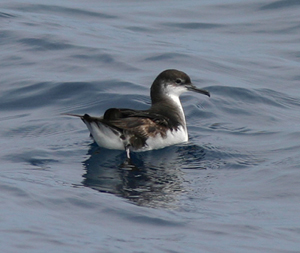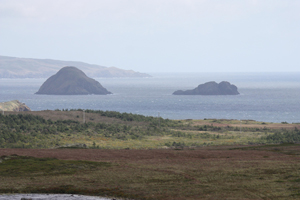Lawn Bay Ecological Reserve encompasses three islands – Middle Lawn Island, Swale Island, and Colombier Island – located near the communities of Lawn and Lord’s Cove on the Burin Peninsula.
- How to get there
- Activities
- Maps
- Services
- Fees and Schedules
- Rules and Regulations
- Permits
- Other Resources
- Contact Information
The small islands within Lawn Bay Ecological Reserve are home to thousands of nesting seabirds. The reserve was established primarily to protect the only known colony of Manx shearwater in North America. The Manx shearwater (Puffinus puffinus) is a nocturnal seabird that nests in burrows up to four feet deep and has been recorded with a lifespan of over 50 years.

The islands also provide habitat for at least seven other breeding seabird species, including a significant colony of Leach’s storm-petrels, smaller numbers of great black-backed gulls, herring gulls, black guillemots, black-legged kittiwakes, common murres and from time to time, arctic and common terns.
Although a small reserve, the islands and waters within Lawn Bay Ecological Reserve are important habitat for thousands of feeding and fledging seabirds. The entire reserve covers 384.6 hectares; 370.7 hectares of this is the marine portion.
The Reserve lies within the Eastern Hyper-oceanic Barrens Ecoregion.
Lawn Bay Ecological Reserve was established as a provisional reserve in 2009, and given full ecological reserve status in 2015.
How to get there
Lawn Bay Ecological Reserve is located off the coast between Lord’s Cove and Lawn on the Burin Peninsula. It is approximately 370 km from St. John’s. From the Trans-Canada Highway’s Goobies turnoff, take the Newfoundland’s Burin Peninsula highway (Route 210).
Visitation to the islands during the breeding season is likely to disturb nesting seabirds and negatively impact seabird eggs, chicks as well as destruction of habitat, particularly burrows. Access to Middle Lawn Island is by special permit only, in order to limit disturbances to seabirds during breeding, and their burrows year-round. During the breeding season (March 15 – October 30), access to Swale and Colombier Islands is also by special permit only. The Islands can be viewed from shore, or viewed from the water. Access to Swale and Colombier Islands is not restricted outside of the breeding season.

During the breeding season, all vessels may approach the islands up to a distance of 100 metres from all islands in the reserve. During the rest of the year, there are no distance restrictions for boats in the marine portion of Lawn Bay Ecological Reserve.
Aircraft are prohibited from landing in the reserve, or flying lower than 300 metres from March 15 to October 30. No tankers or vessels longer than 20 metres are permitted in the marine portion of the reserve.
Activities
During the breeding season (March 15 to October 30), activities other than permitted scientific research are not allowed on any of the islands in the reserve. However, access to Swale and Colombier Islands is not restricted outside of the breeding season.
Commercial and recreational fishing can occur in the waters of the reserve. All provincial and federal regulations apply when fishing in the reserve. Boaters must be careful in the marine portion of the reserve so as not to disturb the birds. To promote stewardship and protection of the reserves seabird populations, fishers are encouraged to fish outside the marine zone and to completely avoid waters within 100 metres of the islands during the breeding season.
There are currently no licensed commercial tour boat operators registered with the Natural Areas Program that can take the public around the islands.
Motorized or non-motorized boats are not permitted within 100 metres of the cliffs containing nesting birds during the breeding season. It is important that any boaters approaching the islands behave responsibly, so as not to disturb the birds.
Services
There are no services within the reserve.
Fees and Schedule
There are no fees involved in obtaining scientific research, educational tour, or commercial operator permits. However scientific research permit applications must be submitted to the Parks and Natural Areas Division by March 31 for review by the Seabird Ecological Reserves Advisory Committee.
Rules and Regulations
Biodiversity protection and habitat conservation are two of the key purposes of ecological reserves, so certain rules apply within all the reserves in the province.
The public can visit most ecological reserves for educational purposes or low-impact recreational activities, such as hiking or sightseeing. These activities have certain restrictions due to the significance and sensitivity of the site. Access to Middle Lawn Island is by special permit only, in order to limit disturbances to seabirds during breeding, and their burrows year-round. During the breeding season (March 15 – October 30), access to Swale and Colombier Islands is also by special permit only. At that time only those conducting approved scientific research, people with valid access permits, and authorized government personnel can visit the seabird nesting areas. There are no access restrictions for hiking on Swale and Colombier Islands outside of the breeding season.
The following activities are strictly prohibited in all wilderness and ecological reserves:
- Disturbing, destroying, or removing plants, animals, or fossils
- Introducing plants, animals, or anything else to the reserve landscape
- Forestry, mining (including exploration), hydro development, agriculture, new roads, tracks, or buildings
- Driving off-road vehicles including all-terrain vehicles (ATVs)
In addition, at Lawn Bay Ecological Reserve:
- No hunting is allowed in the reserve.
- Motorized or non-motorized boats can approach to the islands up to a distance of 100 metres from all islands in the reserve during the breeding season (March 15-Oct 30). During the rest of the year, there are no distance restrictions for boats in the marine portion of Lawn Bay Ecological Reserve.
- Boaters approaching the islands must do so carefully, so as not to disturb the birds.
- Tankers or other vessels longer than 20 metres are not permitted within the marine portion of the reserve.
- Restrictions also apply to cruise ships or tour boat operators – see Permits.
- Commercial and recreational fishing in accordance with other applicable legislation is permitted within the marine waters of the reserve.
- Aircraft are not permitted to fly lower than 300 metres, take off, or land within the reserve from April 1 to October 30.
More information on rules and regulations for scientific researchers, fishers, local residents, commercial tour boat operators, Coast Guard staff, and other potential visitors are available online or by contacting the Natural Areas Program.
Read the official reserve regulations:
